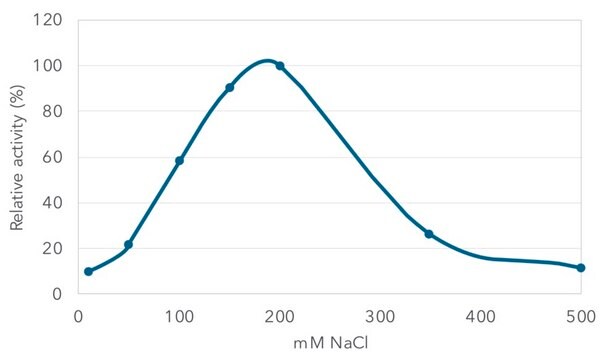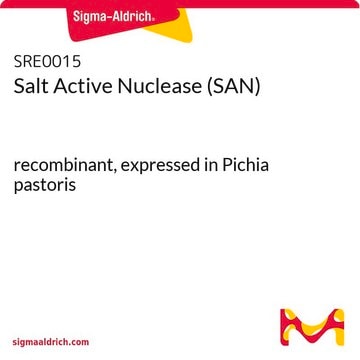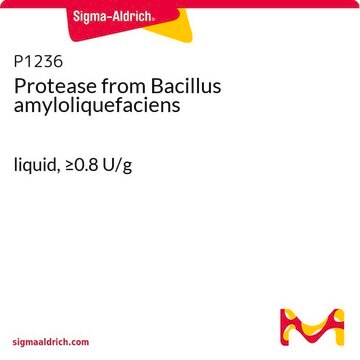SRE0115
Salt Active Nuclease (SAN)
Heat-labile, recombinant, expressed in Pichia pastoris, Triton-free
Sinónimos:
Heat-labile salt active nuclease, endonuclease, salt active endonuclease, salt tolerant nuclease
About This Item
Productos recomendados
recombinant
expressed in Pichia pastoris
Quality Level
specific activity
≥175 000 U/mg
feature
Heat-labile
composition
Triton-free
packaging
pkg of 25 kU
shipped in
dry ice
storage temp.
−20°C
¿Está buscando productos similares? Visita Guía de comparación de productos
General description
This Salt Active Nuclease (SAN) is a nonspecific endonuclease recombinantly produced in Pichia pastoris, with optimum activity at high salt concentrations. It is active in a variety of buffers and can be easily inactivated by treatment with a reducing agent. These features make it particularly useful in the purification of proteins and removal of DNA and RNA from molecular biology reagents. It can be used on cell lysates for viscosity removal, and additionally at the elution step of purification, where there are smaller volumes and a purer protein - allowing for effective and efficient DNA removal.
Application
Features and Benefits
- Active at up to 1M NaCl
Tolerates imidazole and can be separated from most proteins by cation exchange or inactivated by reducing agents.
Unit Definition
Reconstitution
Other Notes
Salt concentration (NaCI / KCI): 150 - 900 mM, optimal: 400 - 650 mM
Mg2+: >1 mM is required for activity, optimal: 5 - 50 mM
pH: 7.3 – 10, optimal: 8.2 - 9.2
Not recommended to use in presence of SDS or urea.
Storage Class
10 - Combustible liquids
wgk_germany
WGK 2
flash_point_f
Not applicable
flash_point_c
Not applicable
Certificados de análisis (COA)
Busque Certificados de análisis (COA) introduciendo el número de lote del producto. Los números de lote se encuentran en la etiqueta del producto después de las palabras «Lot» o «Batch»
¿Ya tiene este producto?
Encuentre la documentación para los productos que ha comprado recientemente en la Biblioteca de documentos.
Nuestro equipo de científicos tiene experiencia en todas las áreas de investigación: Ciencias de la vida, Ciencia de los materiales, Síntesis química, Cromatografía, Analítica y muchas otras.
Póngase en contacto con el Servicio técnico







